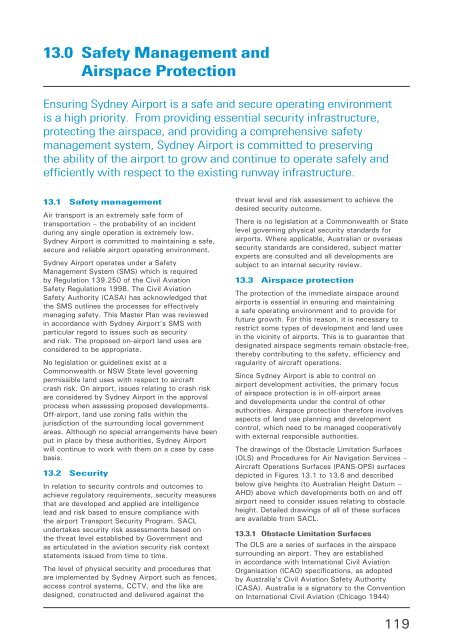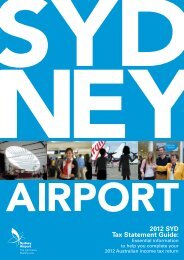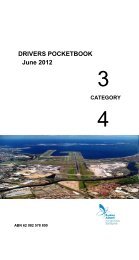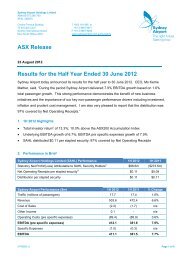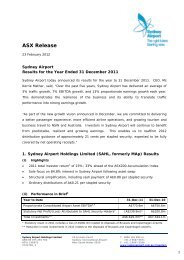Master Plan 2009 - Sydney Airport
Master Plan 2009 - Sydney Airport
Master Plan 2009 - Sydney Airport
You also want an ePaper? Increase the reach of your titles
YUMPU automatically turns print PDFs into web optimized ePapers that Google loves.
13.0 Safety Management and<br />
Airspace Protection<br />
Ensuring <strong>Sydney</strong> <strong>Airport</strong> is a safe and secure operating environment<br />
is a high priority. From providing essential security infrastructure,<br />
protecting the airspace, and providing a comprehensive safety<br />
management system, <strong>Sydney</strong> <strong>Airport</strong> is committed to preserving<br />
the ability of the airport to grow and continue to operate safely and<br />
efficiently with respect to the existing runway infrastructure.<br />
13.1 Safety management<br />
Air transport is an extremely safe form of<br />
transportation – the probability of an incident<br />
during any single operation is extremely low.<br />
<strong>Sydney</strong> <strong>Airport</strong> is committed to maintaining a safe,<br />
secure and reliable airport operating environment.<br />
<strong>Sydney</strong> <strong>Airport</strong> operates under a Safety<br />
Management System (SMS) which is required<br />
by Regulation 139.250 of the Civil Aviation<br />
Safety Regulations 1998. The Civil Aviation<br />
Safety Authority (CASA) has acknowledged that<br />
the SMS outlines the processes for effectively<br />
managing safety. This <strong>Master</strong> <strong>Plan</strong> was reviewed<br />
in accordance with <strong>Sydney</strong> <strong>Airport</strong>’s SMS with<br />
particular regard to issues such as security<br />
and risk. The proposed on-airport land uses are<br />
considered to be appropriate.<br />
No legislation or guidelines exist at a<br />
Commonwealth or NSW State level governing<br />
permissible land uses with respect to aircraft<br />
crash risk. On airport, issues relating to crash risk<br />
are considered by <strong>Sydney</strong> <strong>Airport</strong> in the approval<br />
process when assessing proposed developments.<br />
Off-airport, land use zoning falls within the<br />
jurisdiction of the surrounding local government<br />
areas. Although no special arrangements have been<br />
put in place by these authorities, <strong>Sydney</strong> <strong>Airport</strong><br />
will continue to work with them on a case by case<br />
basis.<br />
13.2 Security<br />
In relation to security controls and outcomes to<br />
achieve regulatory requirements, security measures<br />
that are developed and applied are intelligence<br />
lead and risk based to ensure compliance with<br />
the airport Transport Security Program. SACL<br />
undertakes security risk assessments based on<br />
the threat level established by Government and<br />
as articulated in the aviation security risk context<br />
statements issued from time to time.<br />
The level of physical security and procedures that<br />
are implemented by <strong>Sydney</strong> <strong>Airport</strong> such as fences,<br />
access control systems, CCTV, and the like are<br />
designed, constructed and delivered against the<br />
threat level and risk assessment to achieve the<br />
desired security outcome.<br />
There is no legislation at a Commonwealth or State<br />
level governing physical security standards for<br />
airports. Where applicable, Australian or overseas<br />
security standards are considered, subject matter<br />
experts are consulted and all developments are<br />
subject to an internal security review.<br />
13.3 Airspace protection<br />
The protection of the immediate airspace around<br />
airports is essential in ensuring and maintaining<br />
a safe operating environment and to provide for<br />
future growth. For this reason, it is necessary to<br />
restrict some types of development and land uses<br />
in the vicinity of airports. This is to guarantee that<br />
designated airspace segments remain obstacle-free,<br />
thereby contributing to the safety, efficiency and<br />
regularity of aircraft operations.<br />
Since <strong>Sydney</strong> <strong>Airport</strong> is able to control on<br />
airport development activities, the primary focus<br />
of airspace protection is in off-airport areas<br />
and developments under the control of other<br />
authorities. Airspace protection therefore involves<br />
aspects of land use planning and development<br />
control, which need to be managed cooperatively<br />
with external responsible authorities.<br />
The drawings of the Obstacle Limitation Surfaces<br />
(OLS) and Procedures for Air Navigation Services –<br />
Aircraft Operations Surfaces (PANS-OPS) surfaces<br />
depicted in Figures 13.1 to 13.6 and described<br />
below give heights (to Australian Height Datum –<br />
AHD) above which developments both on and off<br />
airport need to consider issues relating to obstacle<br />
height. Detailed drawings of all of these surfaces<br />
are available from SACL.<br />
13.3.1 Obstacle limitation Surfaces<br />
The OLS are a series of surfaces in the airspace<br />
surrounding an airport. They are established<br />
in accordance with International Civil Aviation<br />
Organisation (ICAO) specifications, as adopted<br />
by Australia’s Civil Aviation Safety Authority<br />
(CASA). Australia is a signatory to the Convention<br />
on International Civil Aviation (Chicago 1944)<br />
119


